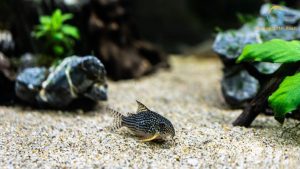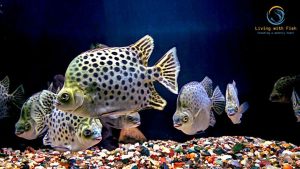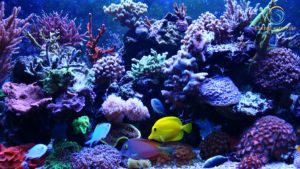Aquarium enthusiasts, new and seasoned alike, are always on the hunt for new additions to their collections. While there are thousands of freshwater fish species to consider, some truly stand out due to their vibrant colors, interesting behavior, and compatibility with other fish. In this post, I’ll talk about some of the best options available for your aquarium.
| Fish Species | Max Length | Behavior | Water Temperature (Fahrenheit) | Diet |
|---|---|---|---|---|
| Betta Fish | Up to 3 inches | Semi-aggressive | 78 – 80 degrees | Omnivore |
| Neon Tetras | Up to 1.2 inches | Peaceful, schooling | 70 – 81 degrees | Omnivore |
| Guppies | Up to 2.5 inches | Peaceful, active | 74 – 82 degrees | Omnivore |
| Angelfish | Up to 6 inches | Semi-aggressive | 75 – 82 degrees | Omnivore |
| Goldfish | Up to 14 inches | Peaceful, interactive | 65 – 75 degrees | Omnivore |
| Cherry Barbs | Up to 2 inches | Peaceful, schooling | 73 – 81 degrees | Omnivore |
| Platies | Up to 3 inches | Peaceful, social | 70 – 80 degrees | Omnivore |
| Zebra Danios | Up to 2 inches | Peaceful, schooling | 65 – 77 degrees | Omnivore |
I hope this table provides a helpful overview. However, this table only scratches the surface of what you need to know about these fish species. For more detailed information about the care and keeping of these aquatic pets, read the full article.
What to Consider Before Choosing Freshwater Fish
Adding new fish to your aquarium is an exciting prospect. However, it’s not as simple as picking the most attractive fish and dropping them into your tank. There are several factors that need to be taken into account to ensure that your fish not only survive but thrive in their new environment. These factors include the size of your aquarium and the fish, the compatibility of the fish species, and the level of care the fish need.
(1) Aquarium Size and Fish Size
The size of your aquarium and the size of the fish you choose to inhabit it are two of the most important factors in setting up a successful and harmonious aquatic environment. Larger fish require more room to swim and explore, while smaller fish can become stressed and unhealthy in an aquarium that’s too big. Similarly, small aquariums can quickly become overcrowded with too many or too large fish, leading to poor water quality and stressed fish.
When choosing your fish, consider their potential adult size. Some fish may seem small in the pet store but can grow significantly, requiring a much larger tank than initially planned. Also, remember that bigger tanks are usually better. Not only do they provide more room for your fish to swim and explore, but they also tend to be more stable in terms of water chemistry, making them easier to maintain.
(2) Compatibility
Not all fish species get along. Just like other animals, fish have different temperaments, dietary needs, and behaviors that can make them more or less compatible with other species. For instance, some fish are peaceful and prefer to live in groups, while others are aggressive or territorial. Some fish may also be fin nippers, which can cause stress and injury to other fish.
When selecting fish, it’s important to research each species’ behaviors, compatibility with other fish, and specific needs. You want to create a balanced ecosystem where all inhabitants can live together in harmony. For example, you wouldn’t want to mix a slow, peaceful species with a fast, aggressive one.
(3) Care Level
Different fish species require different levels of care, from feeding requirements to water temperature and pH preferences. Some fish, like bettas or guppies, are relatively low-maintenance and are great choices for beginners. Other species, like discus or certain types of cichlids, require more advanced knowledge and equipment to thrive.
Consider how much time and effort you’re willing and able to put into your aquarium. If you’re new to fish-keeping, you might want to start with hardier species that can withstand common beginner mistakes. As you gain more experience and confidence, you can start introducing more challenging species.
It’s also important to remember that all fish, regardless of care level, will require a clean, well-maintained environment and a balanced diet to stay healthy.
The underwater world is a fascinating place filled with a wide variety of freshwater fish species, each unique in their own way. Selecting the right species for your aquarium can seem overwhelming given the vast array of options. To help you make the best decision, we will delve deeper into the specifics of some of the top freshwater fish, highlighting their physical characteristics, behaviors, and care requirements.
1. Betta Fish

Originating from the paddy fields of Thailand, Betta fish, or Siamese fighting fish as they’re commonly known, are a vibrant and unique addition to any freshwater aquarium. They exhibit a wide range of colors and fin types, making them one of the most visually appealing freshwater species. Betta fish typically grow no larger than 3 inches in length.
These fish are known for their aggressive nature, especially the males. They are territorial and will often fight with other male Bettas when placed in the same tank. However, they can coexist peacefully with other non-aggressive species of a similar size.
When it comes to their care, Betta fish are relatively low-maintenance, making them an excellent choice for beginners. They thrive in clean, warm water with a temperature of around 78 to 80 degrees Fahrenheit. They also require a varied diet of high-quality betta pellets, frozen, freeze-dried, and live foods like brine shrimp and bloodworms.
2. Neon Tetras

Neon Tetras are named for their glowing blue and red stripes that shimmer under aquarium lights. These petite fish, growing only up to 1.2 inches in length, are native to the freshwater rivers of South America.
Neon Tetras are schooling fish, meaning they prefer to live in groups. They are generally peaceful and coexist well with other non-aggressive species, making them an excellent addition to community tanks.
The care of Neon Tetras is not overly demanding. They prefer a well-planted tank with plenty of hiding spaces. They thrive in slightly acidic water with a temperature between 70 and 81 degrees Fahrenheit. As for diet, they are omnivores and will do well on a diet of flake food, supplemented with small live or frozen foods.
3. Guppies

Guppies, with their vibrant tail colors and playful nature, are a joy to watch. They can exhibit a multitude of colors and patterns, particularly on their tails, which can be a variety of shapes. Guppies are small fish, typically growing up to 2.5 inches in length.
Guppies are known for their lively, active behavior. They enjoy swimming in all levels of the aquarium and are generally peaceful, coexisting well with other non-aggressive fish species.
Guppies are one of the hardiest fish species and can adapt to a wide range of water conditions, making them an ideal choice for beginners. However, they do best in clean, well-aerated water with a temperature between 74 and 82 degrees Fahrenheit. Guppies are omnivores and will happily eat a diet of high-quality flake food, supplemented with occasional servings of live or frozen foods like brine shrimp or daphnia.
4. Angelfish

Characterized by their unique, diamond-shaped bodies and long, flowing fins, Angelfish are undeniably one of the most eye-catching species to grace freshwater aquariums. Their body is usually silver or white, adorned with vertical black stripes that serve as an effective camouflage in their natural habitat. They can grow quite large, with adults reaching up to 6 inches in body length, not including their lengthy fins.
Angelfish are generally peaceful but can show semi-aggressive tendencies, especially during feeding or breeding. They can be territorial, so it’s recommended to house them with other medium to large, non-aggressive species.
When it comes to their care, Angelfish prefer a well-decorated tank with plenty of hiding places, but also enough open space to swim. They thrive in slightly acidic to neutral water with a temperature between 75 and 82 degrees Fahrenheit. They are omnivores and do well on a diet of high-quality flake or pellet food, supplemented with live or frozen foods like brine shrimp or bloodworms.
5. Goldfish

Goldfish are perhaps the most iconic of all aquarium species. They come in a variety of forms, from the common Goldfish with its vibrant gold scales to fancy breeds like the bubble-eyed or lionhead Goldfish. Depending on the variety, a Goldfish can grow quite large, with some types reaching up to 14 inches in length.
Goldfish are known for their friendly and interactive nature. They can become quite personable with their owners and are often seen as the ‘dogs’ of the fish world. However, they are also known to be messy eaters and produce a lot of waste.
Caring for a Goldfish involves a bit more than just a bowl and fish food. Due to their potential size and high waste production, Goldfish require a large, well-filtered tank to stay healthy. They thrive in cooler water temperatures between 65 and 75 degrees Fahrenheit. As for their diet, Goldfish are omnivorous and will appreciate a mix of high-quality pellet food, fresh veggies, and occasional live or frozen foods.
6. Cherry Barbs

Cherry Barbs, named for the males’ bright cherry-red coloring during spawning, are a fantastic addition to a community aquarium. They grow to about 2 inches in length and have a streamlined body shape.
These fish are peaceful and tend to be shy, especially if kept alone. They are schooling fish and feel safest in groups of at least six.
Cherry Barbs prefer a tank that has plenty of plant cover to mimic their natural environment and provide hiding places. They are not overly demanding in terms of water parameters, but they do prefer slightly acidic to neutral water with a temperature between 73 and 81 degrees Fahrenheit. They are omnivores, enjoying a mixed diet of high-quality flake foods, vegetables, and small live or frozen foods.
7. Platies

Platies are popular due to their hardy nature and variety of colors. They are small, reaching a maximum length of 3 inches, and they have a distinctive, laterally compressed body shape.
Platies are peaceful, social fish that do well in community aquariums. They are active swimmers and are often seen exploring the middle and top levels of the tank.
They are easy to care for, which makes them perfect for beginners. Platies thrive in water with a temperature range between 70 and 80 degrees Fahrenheit. They are omnivorous and will do well on a diet of flake foods, vegetables, and occasional treats of live or frozen foods.
8. Zebra Danios

Zebra Danios, with their iconic horizontal stripes, are an active and robust species that add liveliness to any tank. They typically grow to about 2 inches in length.
These fish are peaceful, making them excellent for community tanks. They are schooling fish, so they should be kept in groups of at least five.
Zebra Danios are hardy and adaptable, but they prefer water with a temperature between 65 and 77 degrees Fahrenheit. They are omnivores and enjoy a varied diet of high-quality flake foods and live or frozen foods.
H2: Conclusion
Setting up a freshwater aquarium can be a rewarding experience, and choosing the right fish is a crucial part of that process. Whether you’re a beginner or a seasoned aquarist, there are plenty of freshwater fish species to suit your level of expertise and the environment you can provide. From the vibrant Betta fish to the playful Guppies, each species brings something unique to the table.
Remember, while selecting a fish based on its appearance can be tempting, it’s essential to consider their needs and behaviors to ensure they can live a healthy, fulfilling life in your aquarium. With a bit of research and preparation, you’ll be well on your way to creating a thriving aquatic community. Happy fish-keeping!






